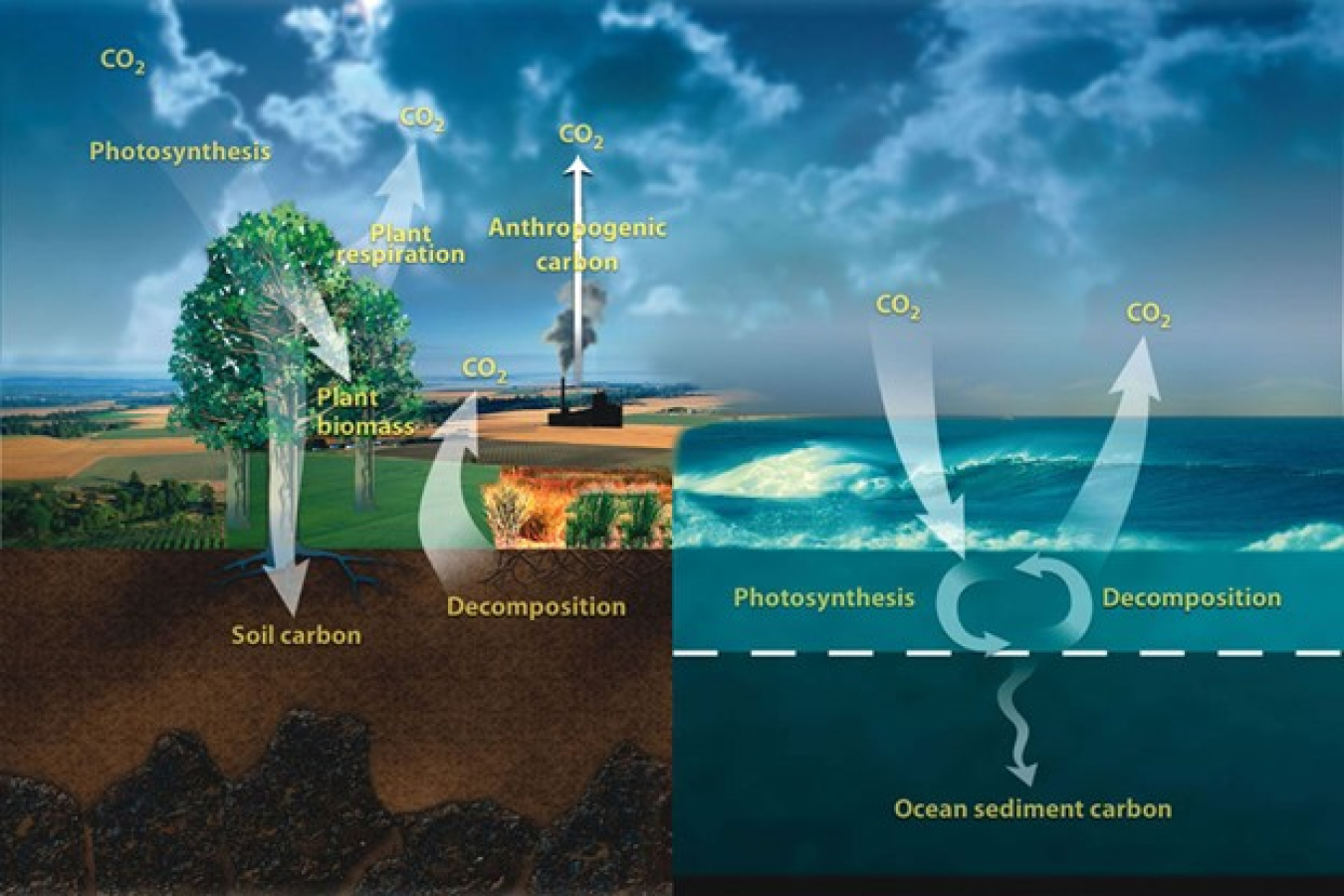
The carbon cycle is the process that moves carbon between plants, animals, and microbes; minerals in the earth; and the atmosphere. Carbon is the fourth most abundant element in the universe. With its ability to form complex molecules such as DNA and proteins, carbon makes life on Earth possible. Carbon in the form of carbon dioxide (CO2) is also an important part of our atmosphere, where it helps to control the Earth’s temperature.
Because only a tiny number of atoms reach the Earth from space, our planet is called a closed system. This means the Earth does not gain or lose carbon. But carbon does move constantly. Most carbon on Earth is stored in rocks and sediments. The rest is in the ocean, atmosphere, and in living organisms. Scientists use the term “carbon sinks” to refer to places where carbon is stored away from the atmosphere.
Plants constantly exchange carbon with the atmosphere. Plants absorb carbon dioxide during photosynthesis and much of this carbon dioxide is then stored in roots, permafrost, grasslands, and forests. Plants and the soil then release carbon dioxide when they decay. Other organisms also release carbon dioxide as they live and die. For example, animals exhale carbon dioxide when they breathe and release carbon dioxide when they decompose. The oceans also exchange carbon with the atmosphere by absorbing carbon, which then sinks as it cools. In addition, carbon is stored in rocks and other geological deposits. For example, coal and other fossil fuels are made of carbon from plants that has been stored under the Earth’s surface for millions of years.
Humans have a huge effect on the carbon cycle when we burn wood, fossil fuels (such as oil, coal, and natural gas), and other forms of carbon. This action releases the stored carbon into the atmosphere, where it becomes a greenhouse gas. Greenhouse gases are gases in the atmosphere that absorb and release heat.
Where carbon is in the cycle shapes our climate. As a greenhouse gas, carbon dioxide in the atmosphere helps to determine how warm the Earth is. Too little carbon dioxide and other greenhouse gases and the Earth would be frozen. Too much would turn the atmosphere into a furnace. That’s why understanding the carbon cycle—and our role in that cycle—is critical to the Earth’s future.
DOE Office of Science: Contributions to Carbon Cycle Research
The Department of Energy (DOE) supports research on the carbon cycle primarily through the Office of Science Biological and Environmental Research (BER) program. BER supports research into atmosphere carbon dioxide and other greenhouse gases. BER also supports systems biology research focusing on plant processes that remove CO2 from the atmosphere and convert it into more stable forms of carbon as well as the complex relationships between plants, their associated microbes (i.e., plant microbiomes), and broader communities of soil microbes that impact carbon cycle processes. In addition to BER, DOE’s Advanced Scientific Computing Research (ASCR) program plays a vital role in studying the carbon cycle with its efforts to improve Earth systems and climate models to better understand how carbon dioxide and other factors shape our planet. DOE also participates in the U.S. Carbon Cycle Science Program, a multi-agency effort to coordinate U.S. carbon cycle science.
Carbon Cycle Facts
- Carbon dioxide is one of the main greenhouse gases, along with methane, nitrous oxide, and a series of industrial gases called fluorinated gases. These are gases that trap heat in the atmosphere.
- Carbon can be removed from the atmosphere using a series of technologies called carbon sequestration, including direct air capture that pulls carbon dioxide straight from the atmosphere.
- In the past, about 25 percent of carbon emissions from human sources have historically been captured by forests, grassland, and farms. And about 30 percent of the carbon dioxide we produce has been captured by the ocean. These percentages will change in the future as humans continue to release carbon dioxide into the atmosphere.
Resources and Related Terms
- DOE Office of Science BER program
- DOE Office of Science ASCR program
- The U.S. Carbon Cycle Science Program
- Science highlight: Warming Soil Means Stronger Microbe Networks
- Science highlight: A Challenging Future for Tropical Forests
- Science highlight: Bacterial Carbon Cycling in Soil Is Not a Shared Effort
Scientific terms can be confusing. DOE Explains offers straightforward explanations of key words and concepts in fundamental science. It also describes how these concepts apply to the work that the Department of Energy’s Office of Science conducts as it helps the United States excel in research across the scientific spectrum.

